German Army Post-1936 Signals NCO/EM's Visor Cap
CATEGORY: Version
SKU: 20.GOR.01.01.01.03.007.000
Estimated market value:

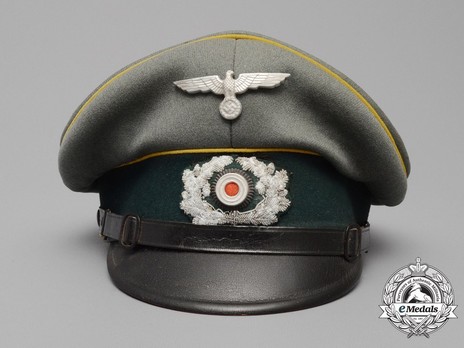
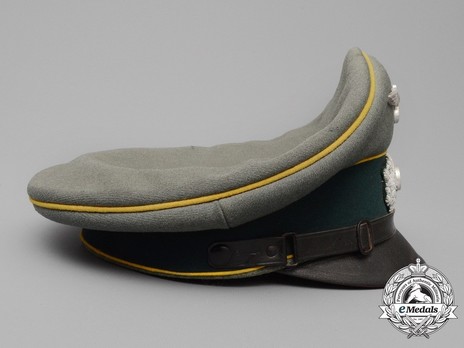
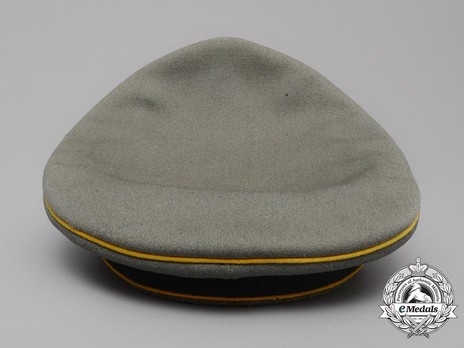
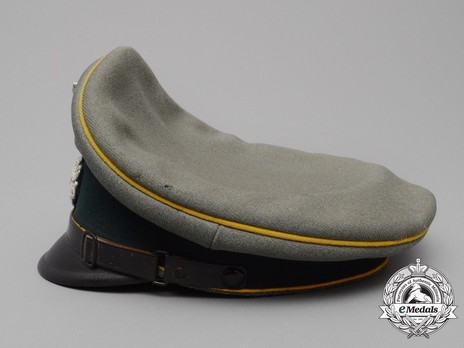
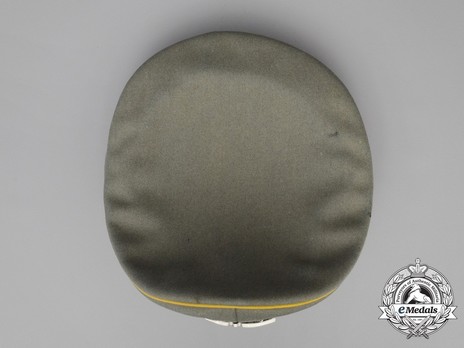

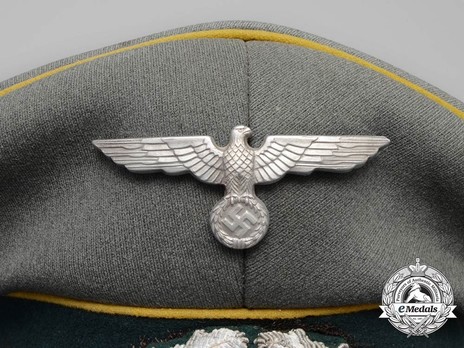
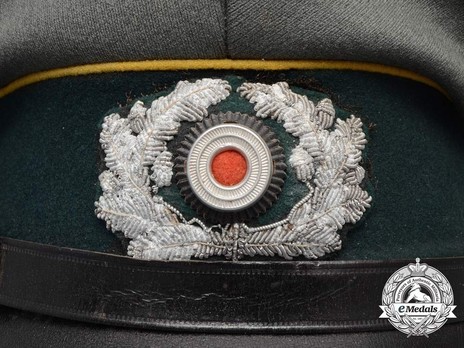
Estimated market value:
This cap is in typical Heer (Army) green doeskin wool with a 43 mm forest green wool band and a traditional high peak with matching yellow piping along the top edge and flanking either side of the band, indicating the branch to be Signals. It is decorated with a well-detailed eagle insignia on the peak in silvered aluminum, plus an open-ended wreath in silvered rolled bullion wire on the band below, interlaced with white threading giving definition to the wreath, surrounding a tri-colour cockade on the band, the cockade with a painted black base incorporating a silvered ring and red felt centre. Three-piece black leather chin strap rests upon the visor housing length adjustment buckles on either side, the straps slotted and wrapped around black-finished magnetic metal buttons on either side. The vulcanfibre visor has a smooth black pebbled-look upper and has a reddish-brown synthetic underside. The sweatband in brown leather, with a folded-up period newspaper entitled "Hannoversche Anzeiger" and dated June 7-8, 1941 under the sweatband at the front, acting as additional padding, with the ends of the sweatband meeting at the rear and are pinned together. The inside of the cap is lined in chocolate brown rayon, with the dome brandishing a diamond-shaped celluloid moisture shield, with its maker identification marks having worn off with time, the cap measuring 225 mm x 257 mm x 140 mm in height overall. The cap exhibits scattered mothing and wear spots on the exterior, with white residue permeating the silvered bullion on the wreath, the sweatband with tape repair on the left side near the front and displaying light soiling overall, with separation evident in the stitching where the sweatband butts the visor, extensive cracking and peeling in the moisture shield. As worn.
The Visor Cap was not a newly developed garment. It had already been well established in the 1920s. The pattern that was used during the Third Reich was established in 1931.
The cap was made of a field grey-green woolen top, a dark green cap band, and a black leather visor. There are three bands of piping, one along the top, one above the cap band, and one below it. Piping is in the colour of the branch type of the wearer, except for General ranks, who had gold-coloured piping.
Enlisted men and NCOs wore a black leather chinstrap. Officers up to General ranks wore a silver-coloured chincord, whereas General ranks wore a gold-coloured one.
The cap has an eagle insignia on the front of the cap band and below it a national cockade in red, white, and black with a circle of oak leaves.
Prices will vary significantly depending on the branch, since caps of certain branches are rare.
Branch colours on German Heer headgear was as follows:
Black was worn by Engineer units.
Black/White was worn by Panzer Engineers.
Copper Brown was worn by Motorcycle personnel.
Light Brown was worn by Signals units until 1936, and by Construction troops.
Carmine was worn by the Führer Staff, General Staff Officers, Staff Officers of the Supreme Command of the Army, and all Veterinary branches.
Bordeaux Red was worn by Smoke & Chemical personnel.
Wine Red was worn by Judicial officials.
Bright Red was worn by Generals, Artillery units, and Ordnance Officers (until 1944).
Rose or Pink was worn by all Armored units (including Panzer troops, and Schützen Brigade Staff).
Orange was worn by Recruiting personnel, Ordnance troops, Ordnance Officers (since 1944), and Field Gendarmerie units.
Bright yellow was worn by Cavalry units, and Light Division Staff.
Lemon yellow was worn by Signal units.
White was worn by Infantry units.
Light Grey was worn by Propaganda personnel.
Grey-Blue was worn by Sonderführer (Specialist Officers).
Violet was worn by Chaplains and Field Bishops.
Cornflower Blue was worn by Medical units, and Supply units.
Bright Blue was worn by Transport troops.
Bright Green was worn by Jäger and Mountain units.
Grass Green was worn by Panzer Grenadier units (Armored Infantry).
Dark Green was worn by Administrative personnel.

Comments
Sign in to comment and reply.


Scroll Top